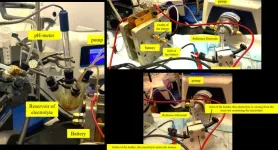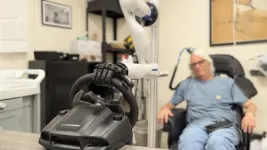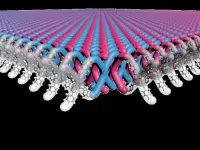(Press-News.org) A team of astronomers led by University of Arizona researcher Catherine Fielder has obtained the most detailed images of a small galaxy and its surroundings, revealing features typically associated with much larger galaxies. The observations provide a rare, elusive glimpse into how small galaxies form and evolve, suggesting that the mechanisms fueling galaxy growth may be more universal than previously thought.
Fielder presented the findings at the 245th meeting of the American Astronomical Society in National Harbor, Maryland, during a press briefing on Jan. 16.
Galaxies, including the Milky Way, grow and evolve by merging with smaller galaxies over billions of years in a process called hierarchical assembly. This cosmic "building block" approach has been well observed in large galaxies, where streams of ancient stars – remnants of swallowed-up galaxies – trace their turbulent history. These streams, along with other faint features such as old, scattered stars, form a so-called stellar halo: a sprawling, low-density cloud of stars that surrounds the bright central disk of a galaxy and traces its evolutionary history.
According to traditional wisdom, smaller galaxies such as the nearby Large Magellanic Cloud may have fewer opportunities to attract mass and merge with smaller systems, including other dwarf galaxies, because of their weaker gravitational pull. Understanding how such galaxies acquire mass and grow in the context of hierarchical assembly remains an open question.
The researchers used the Dark Energy Camera, or DECam, on the 4-meter Blanco Telescope in Chile's Cerro Tololo Inter-American Observatory to conduct a deep imaging survey of 11 dwarf galaxies, including the spiral galaxy NGC 300, which is similar in mass to the Large Magellanic Cloud. The observations were made as part of the DECam Local Volume Survey, or DELVE, and revealed unprecedented details of NGC 300's features. Spanning about 94,000 light-years, NGC 300's galactic disk is a little smaller than the Milky Way and packs only about 2% of its stellar mass.
"NGC 300 is an ideal candidate for such a study because of its isolated location," said Fielder, a research associate at the U of A Steward Observatory. "This keeps it free from the influential effects of a massive companion like the Milky Way, which affects nearby small galaxies like the Large Magellanic Cloud. It's almost a bit like looking at a cosmic 'fossil record.'"
Fielder and her collaborators created stellar maps around the small galaxy and discovered a vast stellar stream extending more than 100,000 light-years from the galaxy's center.
"We consider a stellar stream a telltale sign that a galaxy has accreted mass from its surroundings, because these structures don't form as easily by internal processes," said Fielder, whose findings will be published in The Astrophysical Journal.
In addition, the researchers found traces of stars arranged in shell-like patterns reminiscent of concentric waves emanating from the center of the galaxy, as well as hints of a stream wrap – evidence that whatever caused the stream may have changed direction in its orbit around NGC 300.
"We weren't sure we were going to find anything in any of these small galaxies," she said. "These features around NGC 300 provide us with 'smoking gun' evidence that it did accrete something."
The team also identified a previously unknown, metal-poor globular star cluster in the galaxy's halo, another "smoking gun" of past accretion events.
When gauging the age of stellar populations, astronomers frequently turn to a feature known as "metallicity" – a term referring to the chemical elements present inside stars. Because heavier elements are forged mostly in more massive stars at or near the end of their lifespans, it takes several generations of star formation to enrich those elements. Therefore, stellar populations lacking heavier elements – or having low metallicity – are presumed to be older, Fielder explained.
"The stars in the features we observed around NGC 300 are ancient and metal-poor, telling a clear story," Fielder said. "These structures likely originated from a tiny galaxy that was pulled apart and absorbed into NGC 300."
Together, these findings clearly reveal that even dwarf galaxies can build stellar halos through the accretion of smaller galaxies, echoing the growth patterns seen in larger galaxies, Fielder said.
"NGC 300 now stands as one of the most striking examples of accretion-driven stellar halo assembly in a dwarf galaxy of its kind, shedding light on how galaxies grow and evolve across the universe."
END
Large and small galaxies may grow in ways more similar than expected
New observations suggest that contrary to conventional wisdom, dwarf galaxies can accrete mass from other small galaxies.
2025-01-16
ELSE PRESS RELEASES FROM THIS DATE:
The ins and outs of quinone carbon capture
2025-01-16
Carbon capture, or the isolation and removal of carbon dioxide from the atmosphere during industrial processes like cement mixing or steel production, is widely regarded as a key component of fighting climate change. Existing carbon capture technologies, such as amine scrubbing, are hard to deploy because they require significant energy to operate and involve corrosive compounds.
As a promising alternative, researchers from the Harvard John A. Paulson School of Engineering and Applied Sciences (SEAS) have developed carbon capture systems that use molecules called ...
Laboratory for Laser Energetics at the University of Rochester launches IFE-STAR ecosystem and workforce development initiatives
2025-01-16
The University of Rochester’s Laboratory for Laser Energetics (LLE) has been awarded a $2.25 million grant over three years from the US Department of Energy’s Office of Fusion Energy Sciences. This funding establishes the Inertial Fusion Energy Science and Technology Accelerated Research (IFE-STAR) ecosystem that brings together academia, national laboratories, and the private sector to develop a clean, safe, and virtually limitless energy source, built on US leadership in inertial fusion.
Inertial ...
Most advanced artificial touch for brain-controlled bionic hand
2025-01-16
For the first time ever, a complex sense of touch for individuals living with spinal cord injuries is a step closer to reality. A new study published in Science, paves the way for complex touch sensation through brain stimulation, whilst using an extracorporeal bionic limb, that is attached to a chair or wheelchair.
The researchers, who are all part of the US-based Cortical Bionics Research Group, have discovered a unique method for encoding natural touch sensations of the hand via specific microstimulation patterns in implantable electrodes in the brain. This allows individuals with spinal cord injuries ...
Compounding drought and climate effects disrupt soil water dynamics in grasslands
2025-01-16
A novel field experiment in Austria reveals that compounding climate conditions – namely drought, warming, and elevated atmospheric carbon dioxide (CO2 ) – could fundamentally reshape how water moves through soils in temperate grasslands. The findings provide new insights into post-drought soil water flow, in particular. Soil water, though a minuscule fraction of Earth's total water resources, plays a critical role in sustaining terrestrial life on Earth by regulating biogeochemical cycles, surface energy balance, and plant productivity. Soils also govern ...
Multiyear “megadroughts” becoming longer and more severe under climate change
2025-01-16
Severe droughts are becoming hotter, longer, and increasingly devastating to ecosystems as climate change accelerates, according to a new study, which reports that temperate grasslands, including in parts of the United States, are facing the worst effects. The findings provide a global quantitative understanding of multiyear droughts (MYDs) – prolonged events lasting years or decades – and offer a benchmark for understanding their global trends and impacts. As droughts become more frequent ...
Australopithecines at South African cave site were not eating substantial amounts of meat
2025-01-16
Seven Australopithecus specimens uncovered at the Sterkfontein fossil site in South Africa were herbivorous hominins who did not eat substantial amounts of meat, according to a new study by Tina Lüdecke and colleagues. Lüdecke et al. analyzed organic nitrogen and carbonate carbon isotopes extracted from tooth enamel in the fossil specimens to determine the hominin diets. Some researchers have hypothesized that the incorporation of animal-based foods in early hominin diets led to increased brain size, smaller gut size ...
An AI model developed to design proteins simulates 500 million years of protein evolution in developing new fluorescent protein
2025-01-16
Guided by a multimodal generative language model called ESM3, Thomas Hayes and colleagues generated and synthesized a previously unknown bright fluorescent protein, with a genetic sequence so different from known fluorescent proteins that the researchers say its creation is equivalent to ESM3 simulating 500 million years of biological evolution. The model could provide a new way to “search” the space of protein possibilities with an eye to better understanding how naturally evolved proteins work, as well as developing novel proteins for uses in medicine, environmental remediation, and a host of other applications. ESM3 can reason over protein ...
Fine-tuned brain-computer interface makes prosthetic limbs feel more real
2025-01-16
You can probably complete an amazing number of tasks with your hands without looking at them. But if you put on gloves that muffle your sense of touch, many of those simple tasks become frustrating. Take away proprioception — your ability to sense your body’s relative position and movement — and you might even end up breaking an object or injuring yourself.
“Most people don’t realize how often they rely on touch instead of vision — typing, walking, picking up a flimsy cup of water,” said Charles Greenspon, PhD, a neuroscientist at the University of Chicago. “If you can’t feel, you have ...
New chainmail-like material could be the future of armor
2025-01-16
EVANSTON, Il. --- In a remarkable feat of chemistry, a Northwestern University-led research team has developed the first two-dimensional (2D) mechanically interlocked material.
Resembling the interlocking links in chainmail, the nanoscale material exhibits exceptional flexibility and strength. With further work, it holds promise for use in high-performance, light-weight body armor and other uses that demand lightweight, flexible and tough materials.
Publishing on Friday (Jan. 17) in the journal ...
The megadroughts are upon us
2025-01-16
Increasingly common since 1980, persistent multi-year droughts will continue to advance with the warming climate, warns a study from the Swiss Federal Institute for Forest, Snow, and Landscape Research (WSL), with Professor Francesca Pellicciotti from the Institute of Science and Technology Austria (ISTA) participating. This publicly available forty-year global quantitative inventory, now published in Science, seeks to inform policy regarding the environmental impact of human-induced climate change. It also detected previously ‘overlooked’ events.
Fifteen years of a persistent, devastating megadrought—the longest lasting in a thousand years—have nearly dried out ...
LAST 30 PRESS RELEASES:
Kids’ behavioral health is a growing share of family health costs
Day & night: Cancer disrupts the brain’s natural rhythm
COVID-19 vaccination significantly reduces risk to pregnant women and baby
The role of vaccination in maternal and perinatal outcomes associated with COVID-19 in pregnancy
Mayo Clinic smartwatch system helps parents shorten and defuse children's severe tantrums early
Behavioral health spending spikes to 40% of all children’s health expenditures, nearly doubling in a decade
Digital cognitive behavioral treatment for generalized anxiety disorder
Expenditures for pediatric behavioral health care over time and estimated family financial burden
Air conditioning in nursing homes and mortality during extreme heat
The Alps to lose a record number of glaciers in the next decade
What makes a good proton conductor?
New science reporting guide published for journalists in Bulgaria
New international study reveals major survival gaps among children with cancer
New science reporting guide published for journalists in Turkey
Scientists develop a smarter mRNA therapy that knows which cells to target
Neuroanatomy-informed brain–machine hybrid intelligence for robust acoustic target detection
Eight SwRI hydrogen projects funded by ENERGYWERX
The Lundquist Institute and its start-up company Vitalex Biosciences Announces Strategic Advancement of Second-Generation fungal Vaccine VXV-01 through Phase 1 Trials under $40 Million Competitive Con
Fine particles in pollution are associated with early signs of autoimmune disease
Review article | Towards a Global Ground-Based Earth Observatory (GGBEO): Leveraging existing systems and networks
Penn and UMich create world’s smallest programmable, autonomous robots
Cleveland researchers launch first major study to address ‘hidden performance killer’ in athletes
To connect across politics, try saying what you oppose
Modulating key interaction prevents virus from entering cells
Project explores barriers to NHS career progression facing international medical graduates
Jeonbuk National University researchers explore the impact of different seasonings on the flavor perception of Doenjang soup
Two Keck Medicine of USC Hospitals named Leapfrog Top Teaching Hospitals
World-first discovery uncovers how glioblastoma tumours dodge chemotherapy, potentially opening the door to new treatments
A fatal mix-up: How certain gut bacteria drive multiple sclerosis
New AI tool identifies not just genetic mutations, but the diseases they may cause
[Press-News.org] Large and small galaxies may grow in ways more similar than expectedNew observations suggest that contrary to conventional wisdom, dwarf galaxies can accrete mass from other small galaxies.







